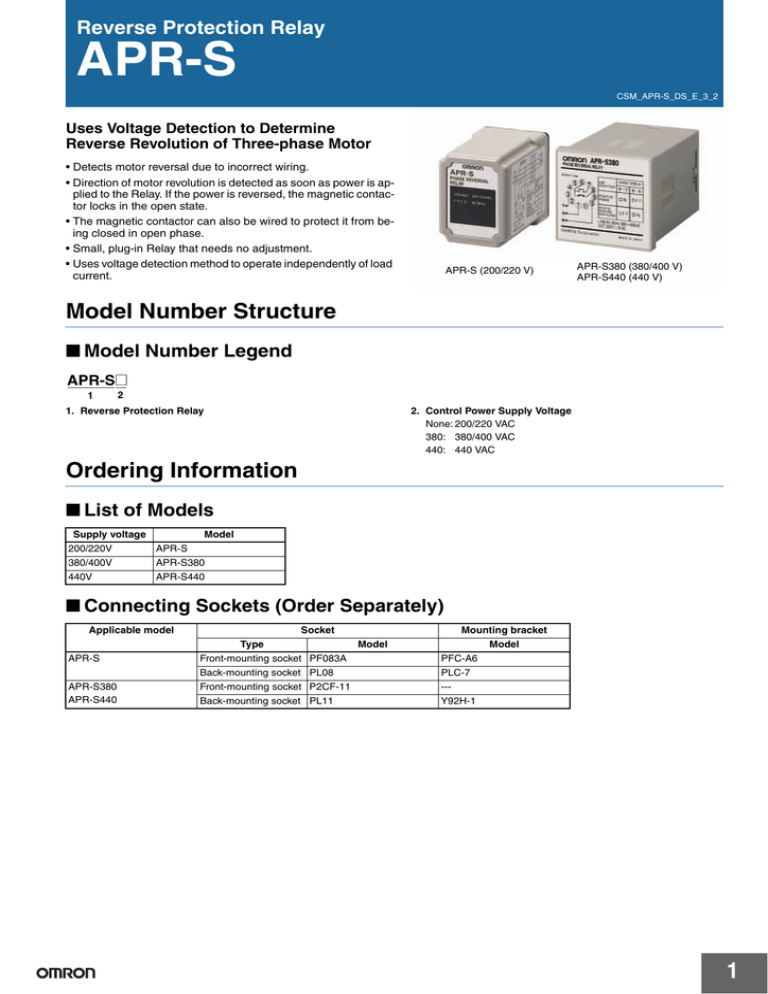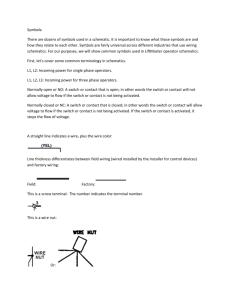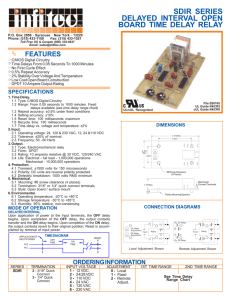
Reverse Protection Relay
APR-S
CSM_APR-S_DS_E_3_2
Uses Voltage Detection to Determine
Reverse Revolution of Three-phase Motor
• Detects motor reversal due to incorrect wiring.
• Direction of motor revolution is detected as soon as power is applied to the Relay. If the power is reversed, the magnetic contactor locks in the open state.
• The magnetic contactor can also be wired to protect it from being closed in open phase.
• Small, plug-in Relay that needs no adjustment.
• Uses voltage detection method to operate independently of load
current.
APR-S (200/220 V)
APR-S380 (380/400 V)
APR-S440 (440 V)
Model Number Structure
■ Model Number Legend
APR-S@
1
2
1. Reverse Protection Relay
2. Control Power Supply Voltage
None: 200/220 VAC
380: 380/400 VAC
440: 440 VAC
Ordering Information
■ List of Models
Supply voltage
Model
200/220V
APR-S
380/400V
APR-S380
440V
APR-S440
■ Connecting Sockets (Order Separately)
Applicable model
Socket
Type
APR-S
APR-S380
APR-S440
Front-mounting socket PF083A
Mounting bracket
Model
Model
PFC-A6
Back-mounting socket PL08
PLC-7
Front-mounting socket P2CF-11
---
Back-mounting socket PL11
Y92H-1
1
APR-S
Specifications
■ Ratings/Characteristics
Type
APR-S
Supply voltage
APR-S380
APR-S440
3-phase, 200/220 VAC, 50/60 Hz
3-phase, 380/400 VAC, 50/60 Hz
3-phase, 440 VAC, 50/60 Hz
350 to 420 VAC
410 to 460 VAC
Operating voltage range
170 to 240 VAC
Operate time
100 ms max. (from power application to detection of motor direction)
Control output
1.1 A at 200 VAC, cosφ = 1, SPDT
2 A at 115 VAC, cosφ = 1
0.6 A at 200 VAC, cosφ = 0.4
1.2 A at 115 VAC, cosφ = 0.4
Insulation resistance
100 MΩ min. (at 500 VDC)
Dielectric strength
2,000 VAC, 50/60 Hz for 1 min
Shock
Malfunction: 98 m/s2 (approx. 10 G)
Ambient temperature
−10 to 50 °C
Life expectancy
Mechanical: 1,000,000 operations min.
Electrical: 100,000 operations min.
Weight
Approx. 100 g
1.1 A at 250 VAC, cosφ = 1, SPDT
0.6 A at 250 VAC, cosφ = 0.4
Connections
To Detect Reverse Phase or Open
Phase
Power supply
200/220 VAC
R S T
4
Power supply
380/400 VAC
R S T
5
3
6
2
7
1
To Switch to Reverse Phase
APR-S380
8
APR-S Reverse
Protection Relay
ContactorNote:
M
Conductor control
power supply
Use separate power supplies
for the contact’s applied voltage and control voltage.
Contactor
M
Operation
• Suppose the motor revolves in the forward direction when the input
terminals F, D, and C of the APR-S are connected, in this
sequence, to the power lines. The APR-S Relay turns ON when the
phase sequence of the voltage is in the forward direction, that is,
when the power lines R, S, and T are energized in this sequence.
When the Relay turns ON, terminals E and A conduct, energizing
the contactor. If one of the three phases is reversed, the Relay
does not turn ON and the contactor is not energized.
• To protect the motor from damage due to open phase, the wiring
must be performed in exactly the same way as shown in this figure
(i.e., so that the phase connecting the contactor coil is not the same
as the phase connecting terminal D of the Relay).
If phase R or T is open, the contactor does not operate because
one side of its coil is not energized. If phase S (connected to terminal D of the Relay) opens, the Relay does not turn ON, allowing no
current flow between terminals E and A. The contactor therefore
does not operate.
Note, however, that the contactor is prevented from operating by
preventing an open-phase voltage from flowing into the motor and
not by the open-phase protection feature of the Relay.
Operation
• Suppose the motor revolves in the forward direction when the input
terminals J, A, and C of the APR-S are connected, in this
sequence, to the power lines R, S, and T, respectively. The APR-S
Relay turns ON when the phase sequence of the current is in the
forward direction, that is, when the power lines R, S, and T are
energized in this sequence. When the Relay turns ON, terminals F
and G conduct, energizing the contactor. If one of the three phases
is reversed, the Relay does not turn ON, and terminals F and G
do not conduct, but a current flows between terminals F and H,
energizing the reverse-phase contactor.
Note: Open-phase detection is not possible.
Note: Open-phase detection is only possible when a 200/220-VAC
APR-S is used with the wiring exactly the same as shown in the
above diagram.
2
APR-S
Accessories (Order Separately)
■ Dimensions
APR-S
APR-S
50
84.9
68.9
63.9
77.5
38
13.6
PF083A (Order separately)
APR-S
16
PL08 (Order separately)
APR-S380/S440
1
78
6
63.7
0.7
13.6
APR-S380
103
77
44.8 × 44.8
48
48
P2CF-11 (Order separately)
16
APR-S380
Y92H-1
Hook
PL11
(Order separately)
■ Terminal Arrangement
APR-S380/S440
APR-S
4
5
3
6
2
7
1
8
(Bottom View)
5 6 7
8
4
9
3
2
10
1 11
(Bottom View)
3
APR-S
■ Accessories for Track Mounting
PFP-100N/PFP-50N Socket Mounting Track
7.3±0.15
35±0.3
4.5
15
25 10 25
27±0.15
15 (5)*
25 10 25
1
1,000 (500)*
* The dimensions given in parentheses are for the PFP-50N Socket Mounting Track.
PFP-100N2 Socket Mounting Track
16
4.5
35±0.3 27
15
25 10 25
25 10 25
15
29.2
24
1
1.5
1000
PFP-M End Plate
10
6.2
M4×8
pan head
50 screw
1.8
1
1.8
35.5 35.5
11.5
1.3
10
M4 spring washer
Spacer
4.8
16
12
5
34.8
44.3
16.5
4
APR-S
Safety Precautions
■ Correct Use
• With the APR-S, APR-S380, or APR-S440 an open phase at startup can be
prevented only if connections are external and wiring has been performed to
detect reverse phase and open phase at startup when the power supply is
turned ON. When doing so, use an SE Static Motor Relay. An open phase
when the power supply is turned ON can be detected only when it occurs
between the APR-S, APR-S380, or APR-S440 and the power supply. An open
phase cannot be detected on the load side.
• Suppose the motor revolves in the forward direction when the input terminals 6,
4, and 3 of the APR-S are connected, in this sequence, to the power lines. If the
phase sequence of the power supply applied to the APR-S is a positive
sequence (i.e., applying to R to S to T in the order of 6 to 4 to 3), the relay built
into the APR-S will turn ON, there will be continuity between terminals 5 and 1,
and the contactor will be energized. For reverse phase, the built-in relay will not
turn ON and the contactor will not be energized.
• The positive phase sequence for the APR-S380 or APR-S440
corresponds to the following order of the input terminals: 10 to 1 to 3.
If the phase sequence of the power supply applied to the APR-S380 or APRS440 is a positive sequence (i.e., applying to R to S to T in the order of 10 to 1
to 3), the relay built into the APR-S380 or APR-S440 will turn ON, there will be
continuity between terminals 6 and 7, and the contactor will be energized.
For reverse phase, the built-in relay will not turn ON and the
contactor will not be energized.
• An open phase when the power is turned ON cannot be detected
by the APR-S380 or APR-S440.
• An open phase when the power is turned ON can be prevented when
wiring is performed exactly as in the following figure (when wiring is
performed so that the phase of the connected contactor coil for turning
ON the power supply and the phase of the connected terminal 4 of the
APR-S, APR-S380, or APR-S440 are not the same phase).
Mounting
• If a back-mounting socket is used for mounting, mount the socket
flush from the back of the panel (thickness: 1 to 4 mm) using
screws, and insert the APR-S after the socket is sufficiently
tightened. Make sure the socket is mounted with the key slot
downward.
• If a front-mounting socket is used, mount the socket to the panel
using screws, and insert the APR-S after the socket is sufficiently
tightened.
• Use a mounting bracket to secure the APR-S reliably and prevent
contact faults.
Switching to Reverse Phase
Power supply
200/220 VAC
R S T
4
APR-S
Reverse
Protection
Relay
Control
power
supply
5
3
6
2
7
1
8
Operation Chart
Example: APR-S380
Positive-phase Voltage
Reverse-phase Voltage
AC380V
M1
AC380V
Input voltage
Input voltage
Positive phase
Positive phase
Reverse phase
Reverse phase
Positive-phase
power-ON
contactor
Continuity
Between terminals No
6 and 7 continuity
Reverse-phase
power-ON contactor
Between terminals
6 and 7 No continuity
Continuity
Continuity
Between terminals
6 and 8
M2
No continuity
Between terminals
6 and 8
M
Power supply
200/220 VAC
R S T
4
5
6
3
2
7
1
8
APR-S Reverse
Protection Relay
• Suppose the motor revolves in the forward direction when the input
terminals 6, 4, and 3 of the APR-S are connected, in this sequence
to the power lines, R, S, and T, respectively. If the phase sequence
of the power supply applied is the positive sequence, the relay built
into the APR-S will turn ON, there will be continuity between
terminals 5 and 1, and the positive-phase power-ON contactor will
be energized.
For reverse phase, the built-in relay will not turn ON, there will be
conductivity between terminals 5 to 8, and the reverse-phase
power-ON contactor will be energized. In this way, the voltage
supplied to the motor will remain positive phase whether the
voltage applied is positive phase or reverse phase.
Note
Contactor
M
In the figure above, one side of the contactor coil will not be energized
if either phase R or phase T is open phase, so the power supply will not
turn ON. For open R phase (APR-S terminal 4), the built-in relay of the
APR-S will not turn ON, and there will be no conductivity between
terminals 5 and 1, so the contactor will not operate, and the power
supply will not turn ON. This protection is for an open phase when
the power is turned ON and cannot ensure detection of an open
phase when the motor is operating.
• Incorrect wiring on the magnet contactor load side cannot be detected.
• A phase detection method is used, so usage is not possible with single phase.
The APR-S requires 100 ms after the voltage has been applied
until positive phase and reverse phase are detected. Be sure to
allow at least 100 ms to elapse before applying voltage to the
control power supply after applying voltage to the APR-S.
ALL DIMENSIONS SHOWN ARE IN MILLIMETERS.
To convert millimeters into inches, multiply by 0.03937. To convert grams into ounces, multiply by 0.03527.
In the interest of product improvement, specifications are subject to change without notice.
5
Terms and Conditions Agreement
Read and understand this catalog.
Please read and understand this catalog before purchasing the products. Please consult your OMRON representative if you
have any questions or comments.
Warranties.
(a) Exclusive Warranty. Omron’s exclusive warranty is that the Products will be free from defects in materials and workmanship
for a period of twelve months from the date of sale by Omron (or such other period expressed in writing by Omron). Omron
disclaims all other warranties, express or implied.
(b) Limitations. OMRON MAKES NO WARRANTY OR REPRESENTATION, EXPRESS OR IMPLIED, ABOUT
NON-INFRINGEMENT, MERCHANTABILITY OR FITNESS FOR A PARTICULAR PURPOSE OF THE PRODUCTS. BUYER
ACKNOWLEDGES THAT IT ALONE HAS DETERMINED THAT THE
PRODUCTS WILL SUITABLY MEET THE REQUIREMENTS OF THEIR INTENDED USE.
Omron further disclaims all warranties and responsibility of any type for claims or expenses based on infringement by the
Products or otherwise of any intellectual property right. (c) Buyer Remedy. Omron’s sole obligation hereunder shall be, at
Omron’s election, to (i) replace (in the form originally shipped with Buyer responsible for labor charges for removal or
replacement thereof) the non-complying Product, (ii) repair the non-complying Product, or (iii) repay or credit Buyer an amount
equal to the purchase price of the non-complying Product; provided that in no event shall Omron be responsible for warranty,
repair, indemnity or any other claims or expenses regarding the Products unless Omron’s analysis confirms that the Products
were properly handled, stored, installed and maintained and not subject to contamination, abuse, misuse or inappropriate
modification. Return of any Products by Buyer must be approved in writing by Omron before shipment. Omron Companies shall
not be liable for the suitability or unsuitability or the results from the use of Products in combination with any electrical or
electronic components, circuits, system assemblies or any other materials or substances or environments. Any advice,
recommendations or information given orally or in writing, are not to be construed as an amendment or addition to the above
warranty.
See http://www.omron.com/global/ or contact your Omron representative for published information.
Limitation on Liability; Etc.
OMRON COMPANIES SHALL NOT BE LIABLE FOR SPECIAL, INDIRECT, INCIDENTAL, OR CONSEQUENTIAL DAMAGES,
LOSS OF PROFITS OR PRODUCTION OR COMMERCIAL LOSS IN ANY WAY CONNECTED WITH THE PRODUCTS,
WHETHER SUCH CLAIM IS BASED IN CONTRACT, WARRANTY, NEGLIGENCE OR STRICT LIABILITY.
Further, in no event shall liability of Omron Companies exceed the individual price of the Product on which liability is asserted.
Suitability of Use.
Omron Companies shall not be responsible for conformity with any standards, codes or regulations which apply to the
combination of the Product in the Buyer’s application or use of the Product. At Buyer’s request, Omron will provide applicable
third party certification documents identifying ratings and limitations of use which apply to the Product. This information by itself
is not sufficient for a complete determination of the suitability of the Product in combination with the end product, machine,
system, or other application or use. Buyer shall be solely responsible for determining appropriateness of the particular Product
with respect to Buyer’s application, product or system. Buyer shall take application responsibility in all cases.
NEVER USE THE PRODUCT FOR AN APPLICATION INVOLVING SERIOUS RISK TO LIFE OR PROPERTY OR IN LARGE
QUANTITIES WITHOUT ENSURING THAT THE SYSTEM AS A WHOLE HAS BEEN DESIGNED TO ADDRESS THE RISKS,
AND THAT THE OMRON PRODUCT(S) IS PROPERLY RATED AND INSTALLED FOR THE INTENDED USE WITHIN THE
OVERALL EQUIPMENT OR SYSTEM.
Programmable Products.
Omron Companies shall not be responsible for the user’s programming of a programmable Product, or any consequence
thereof.
Performance Data.
Data presented in Omron Company websites, catalogs and other materials is provided as a guide for the user in determining
suitability and does not constitute a warranty. It may represent the result of Omron’s test conditions, and the user must correlate
it to actual application requirements. Actual performance is subject to the Omron’s Warranty and Limitations of Liability.
Change in Specifications.
Product specifications and accessories may be changed at any time based on improvements and other reasons. It is our
practice to change part numbers when published ratings or features are changed, or when significant construction changes are
made. However, some specifications of the Product may be changed without any notice. When in doubt, special part numbers
may be assigned to fix or establish key specifications for your application. Please consult with your Omron’s representative at
any time to confirm actual specifications of purchased Product.
Errors and Omissions.
Information presented by Omron Companies has been checked and is believed to be accurate; however, no responsibility is
assumed for clerical, typographical or proofreading errors or omissions.
2016.4
In the interest of product improvement, specifications are subject to change without notice.
OMRON Corporation
Industrial Automation Company
http://www.ia.omron.com/
(c)Copyright OMRON Corporation 2016 All Right Reserved.



